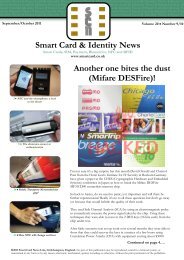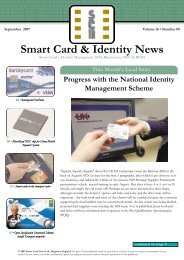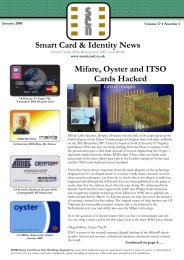Smart Card Identity News - Smart Card News
Smart Card Identity News - Smart Card News
Smart Card Identity News - Smart Card News
Create successful ePaper yourself
Turn your PDF publications into a flip-book with our unique Google optimized e-Paper software.
Level 4 - Interoperability: On the highest level (level 4) of an automatic fare collection<br />
(AFC) system, where the CSC is used on several means of transportation<br />
operated by several independent transport operators in several locations, we are<br />
challenged with many new and completely different tasks. It is the only level, definition<br />
or configuration of an automatic fare collection (AFC) system, where we<br />
should use the term "interoperability", because it is the first time that several transport<br />
operators cooperate in one and the same CSC scheme.<br />
Hence, interoperability can be described as the extent to which a travel card issued by one public transport<br />
operator can be used by other public transport operators. Whereas the usage and availability of system and<br />
application objects should be analyzed and discussed on level 1 (interusability), level 2 (intermodality), and<br />
level 3 (interavailability), level 4 (interoperability) focuses more on commercial issues rather than on the CSC<br />
technology itself. (Remark: on level 1, 2 and 3, commercial agreements are normally only necessary if tickets<br />
are distributed and sold through sales agents). The fact that several transport operators work together has a<br />
significant impact on the backend system, data model and security framework that goes from the backend<br />
right the way out to and into the CSC underlying data model.<br />
To guarantee interoperability, all involved transport operators must agree on the following:<br />
1) business rules; 2) rights and duties; 3) roles and responsibilities; 4) clearing<br />
- to apportion revenues; 5) security & key management. Other topics that have<br />
to be taken into consideration with respect to system-wide interoperability are: 1)<br />
card formats; 2) system interfaces. Many countries have started to be active in this<br />
area - see these two examples: 1) Australian state governments - Australian Transport<br />
Interoperability Protocol (ATIP); 2) American Public Transportation Association<br />
(APTA) - Universal Transit Fare System (UTFS).<br />
In Europe, many associations and public institutions such as the Public Road Administration in Norway,<br />
Resekortsföreningen i Norden (RKF) in Sweden and Denmark, ITSO in the UK and the Verband Deutscher<br />
Verkehrsunternehmen (VDV) in Germany have put significant efforts into the standardisation of interoperable<br />
fare collection systems and therefore, achieved substantial progress.<br />
Besides these national and transnational initiatives, new standards evolve and try to provide transport operators<br />
and authorities with a conceptual framework for interoperability on a European as well as on an International<br />
level: 1) EN15320 - Interoperable Public Transport Application (IOPTA); 2) ISO 24014-1 - Interoperable<br />
Fare Management System (IFMS).<br />
What's the impact for my business? - If a transport operator is not sure about<br />
which level he is confronted with or which level he needs a solution for, he might<br />
end up with a completely over-qualified or under-qualified automatic fare collection<br />
(AFC) system. This can create exceedingly high costs at the beginning of an<br />
e-ticketing project or extraordinary expenses at a later stage of a project for updates<br />
and modifications.<br />
Or you get involved in continuous discussions over what solution on what level to use creating an incredibly<br />
long time to market for your CSC based public transport system. As a consequence, users don't benefit from<br />
this simple, convenient and user-friendly solution, which could make their mobility and life much easier, safer<br />
and enjoyable and don't ride public transport more often than before.<br />
Industry Insight<br />
Thus, it is highly recommended that transport operators use available ISO or CEN standards and open specifications<br />
on all 4 described levels (incl. security, data model, transmission, etc.) as much as possible to avoid<br />
costly implementations of proprietary and non-compatible systems, which make interoperability impossible.<br />
In other words, interoperability is the real ticket to success for contactless <strong>Smart</strong> <strong>Card</strong>s in public transport<br />
systems. Isn't it about time that we discuss interoperability, its challenges and its real-life implications for<br />
public transport operators and users?<br />
14<br />
<strong>Smart</strong> <strong>Card</strong> & <strong>Identity</strong> <strong>News</strong> • July 2007
















